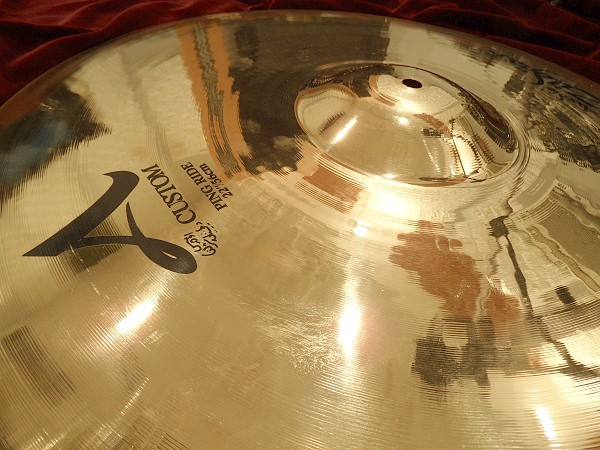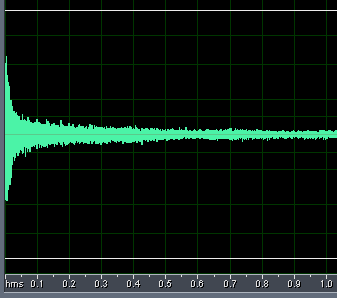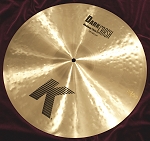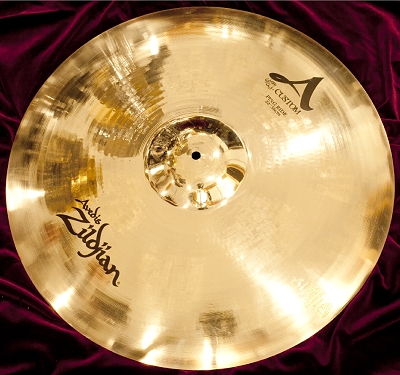Classic jazz drummers have tended to use ride cymbals where the sound of the ping is just above (in loudness) a broad wash, with the wash being dark. Often, this is a 20″ cymbal that is medium or medium thin in weight. Jazz drummers still use this type of cymbal, but there are also a number of modern jazz drummers, and certainly drummers in the rock scene, where a distinct ping sound in desired. Especially at a metal rock concert, where the amp stacks are maxed out on volume, unless the ride cymbal has a strong ping, it simply will not be heard by the audience. Zildjian makes several ride cymbals that have strong ping sounds to them, but this one is focused on the ping, at the expense of the wash (i.e., making it sound “dry”), for that certain drummer who really loves the ping sound. It is the 22″ A Custom Ping Ride.
There are a number of ways to make a cymbal focus its sound on the ping, rather than expend some of the energy on the ping and some on the wash. One way is to hammer the cymbal heavily and either do no lathing, or very light lathing. A second method – and it does not exclude using the first method along with it – is to form a smaller bell. The smaller the bell, the drier they sound. The larger the bell, the more musical (more wash) the cymbal will have.
Interestingly, if at the last step, after all hammering and lathing is done, the cymbal is heated to just below the recrystalization temperature, and then suspended by a support through the center hole, and allowed to cool on its own in air at room temperature, rather than the usual quenching in water, it can end up with a very musical wash, but yet, still have a bright ping. This process is known as “annealing”, and results in a softer metal product with less internal stresses (hammering produces internal stresses). The process known as “tempering” refers to the same heating and air cooling with metal that has been heated and quenched, but not yet hammered or lathed. For cymbals made from sheet metal, the cold-rolled cymbal alloy sheet metal is cut into the cymbal circular shape, then the bell is formed under pressure, and it is hammered. Because it is not heated during the cymbal-making procedure (except for cymbals made by custom cymbal shops), the metal is now under tremendous internal stress. So, you will usually see very deep lathing on these cymbals, which helps to “open up” the cymbal (literally), relieving some of the stresses, and allowing the cymbal to be more musical.
The Zildjian 22″ A Custom Ping Ride Cymbal is hammered and finely lathed. The bell is small, lathed, but not hammered.
The sound is very dry, with an intense ping. Just what the doctor ordered for those rock concerts, but also, a modern jazz drummer, using a 7A stick, and playing the ride lightly, would obtain a terrific sound that could almost be used by the rest of the band members as a substitute for a click track. I mean, this thing Pings! A metal rock drummer, putting a new Zildjian A Custom Ping Ride in his/her kit for the first time, would certainly get comments from the rest of the group. And, the audience would be able to hear it, no matter how loud they are screaming. I don’t particularly care for the sound when it is crashed, but the bell is as “pingy” as the body, and with more musicality (less dry).
Specifications
- Manufacturer Line: A Custom
- Type: Ping Ride
- Style: Heavy
- Alloy: B20 – CuSn20 – 80% Copper, 20% Tin
- Diameter: 22″
- Metal Work: Machine Hammered, Machine Lathed, Brilliant Finish
- Weight: 5 Pounds
- MSRP: $591 USA; Street Price $335
- Zildjian
In the close-up photo, you can see the small, tightly spaced hammer marks just to the right of where the ink stamp “22” is located. The pattern is characteristic of the rotary hammering process that Zildjian mentions in their product descriptions for the A Custom series. (The way to identify hammer marks on a brilliant finish cymbal is to look for where the light reflection of the background bends.)

Spectral analysis shows very large peaks at 320 Hz, 440 Hz, 650 Hz, and 810 Hz. Then the response is lower in the 1 kHz – 3 kHz range, before ramping up to another peak at 8.5 kHz, and dropping off sharply out to 45 kHz. It is the concentration of peaks in the 6 kHz – 8 kHz range, that produces the dry ping sound.

The ping is sharp with a quick decay.

Click HERE to listen to an audio sample, which will include crash (when appropriate), ride, and bell sounds (these are 24 bit, 176.4 kHz wav files, so be sure your sound card is capable of handling these high resolution sound files).
If your sound card cannot play the high resolution file, click HERE to listen to an MP3 sound file.



